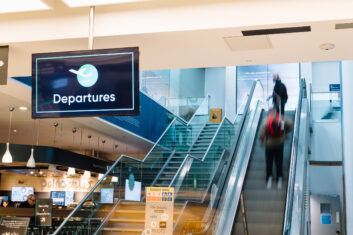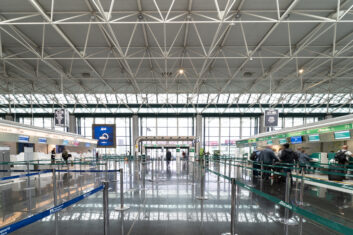Public address (PA) systems for the transport sector occupy a strange place in the psyche of the travelling public. On the one hand they deliver updates on what is happening with a train or flight. On the other hand, these vital notifications can often fall foul of poor acoustic environments within the station, on the platforms or in airport concourses. Which is massively frustrating and has led to a historically low opinion of travel announcements and the associated audio quality.
Regardless of this, PA and – more crucially – voice alarm (VA) system remain both necessary and an integral part of the travelling experience. And, observes Neil Voce, president of the ISCVE (Institute of Sound, Communications and Visual Engineers), improvements have been made over time even though the bad reputation sustains.
“Transport terminals have definitely seen a considerable improvement in audio quality over the last couple of decades,” he says. “A combination of regulation due to voice alarm intelligibility requirements and the increased use of technologies such as powered line arrays and ambient noise tracking systems have raised the bar on what’s acceptable in a terminus. All systems also have the benefit of closer integration with train timetabling and movement databases to offer more accurate passenger information.”
SPEECH INTELLIGIBILITY
On the thorny issue of speech intelligibility, Voce comments that – for the UK at least – the introduction of Railway (Interoperability) Regulations 2011 for larger rail station installations setting a minimum requirement of 0.45 STI (Speech Transmission Index), plus the parallel usage for VA, has driven improvements in system performance.
Peter Alberry-King, general manager for sales and technical at loudspeaker manufacturer Penton UK, adds that this stipulation relates to a target coverage of 95 percent, although he is of the opinion that 0.45-0.5 is “not great intelligibility”.

Instead, he describes it as “acceptable”, citing 0.6 to 0.7 STI as good quality speech. The reality is that most passengers are not expecting hi-fi reproduction and merely expect something they can understand and which conveys the information they need for their journeys.
As Alberry-King says, any lingering or continuing dissatisfaction with the sound in railway stations and other transport hubs is now more likely to come from inconsistencies between different parts of a station. “There can be a difference between the systems and acoustics on the main rail concourse and those in the Underground station,” he explains. “The environment can also change if partitioning is put in for additional retail premises.”
Alberry-King acknowledges that PA/VA standards, such as BS 5839, have helped in establishing minimum intelligibility. BS 5839 was first published in 1988 and primarily aimed at fire alarm and detection systems, although it also included specifications for integration with PAs. A 2013 revision, 5839-8, set out a code of practice for the design, installation, commissioning and maintenance of VA systems. Alberry-King comments that in modern installations for transportation, it is becoming increasingly common for announcements to be carried through the VA system rather than the general PA. “The quality is better,” he says, “and the stored, synthetic messages for regular announcements are also better, with more attention to intelligibility.”
DIGITALLY ACTIVE
Another change in transport installations has been the adoption of digital active line arrays, which incorporate steerable capability. “They are very effective and able to overcome reverberance but they are expensive,” Alberry-King says. Penton produces its own range of active line arrays, as do Duran Audio with the Intellivox range (now part of JBL/Harman), TOA and RCF. Ian Bridgewater, director and technical sales manager at TOA UK, observes that “developments in speaker profiles and technology” have led to better sound in transport situations.
“Variable line arrays that can be angled and long-range horn array speakers, which can deliver audio over double the distance of what a conventional speaker can cover, gives greater scope in the design process,” he says. “PA/VA systems should be specifically designed for each individual application; using EASE to create acoustic simulation for each area of the project allows technical experts to design robust and exceptional audio systems specifically for the space dimensions.”
Like all enclosures for VA purposes, those installed for transport have to be EN-54 (the European standard for fire detection and alarm systems) certified, with the capability to be fitted both indoors and outdoors. In terms of other recent technological advances, Bridgewater cites connectivity between PA/VA and Automated Announcement Systems (ASS) and Text-To Speech (TTS), which is triggered directly from the AODB (Airport Operational Database). This was developed by TOA in collaboration with its Airport System Software Partners and connects the PA/VA system directly to Flight Information Display Boards.
STEERABLE ARRAYS
Antonio Ferrari, director of the engineering support group and market manager for audio contracting at RCF, similarly highlights steerable arrays but also high directivity point source units as being “very helpful” in improving sound quality for “challenging acoustics”. He adds that distortion plays a “significant role” in speech intelligibility, which is why RCF’s new DMA and XPS standalone amplifiers, along with its onboard amps, feature proprietary algorithms for phase linearity. As for the general approach to transport sound, Ferrari says, “It is in the interests of the operators to provide the quality of the messages, both security and routine ones, for their passengers. Furthermore, the less effort required to hear makes for a more relaxed, happier customer.”

As might be hoped, new transport projects with substantial budgets have paid more attention to creating an environment conducive to intelligible, good quality sound. “The newly finished Elizabeth Line in London has really well-managed acoustics compared to any early Tube line where the building acoustics was never considered,” comments Neil Voce. “But when you reach large stations, you do also have to be wary of not overdoing the housekeeping messages – it’s really painful for travellers if the PA never takes a break from telling you about planned engineering works, not to smoke, to carry water and so on. This has now become a more active area for consideration.”
Last year the UK Department for Transport (DfT) began a review of train announcements with the aim of removing those deemed superfluous and which add “unnecessary noise and disruption to journeys”. The focus of the survey was onboard announcements on trains in England, looking at how the number of announcements can be cut or reduced while still maintaining necessary obligations to ensure train travel remains accessible for everyone.
The then chief executive of passenger group Transport Focus, Anthony Smith, responded: “Passengers will welcome a review intended to cut out unnecessary announcements. Transport Focus looks forward to helping with the review so passengers get the information they want, including those with additional accessibility needs.”
DISPLAY-BASED
Jacqueline Starr, chief executive of British rail industry membership body the Rail Delivery Group (also known by its trading name of National Rail), added: “We know people want the most relevant and timely messages on their journeys and to help with this, train operators are continuing their work to improve customer information, including cutting unnecessary onboard announcements.”

National Rail’s most recently published InfoTracker Survey (for April to June 2023) shows that its website and app was the most used source of information, except for when passengers were at stations or on trains. In these circumstances the survey found that passengers were using screens on the platform and on trains or way-finding signage, with apps as a complementary channel, rather than PA announcements.
This shift towards visual, display-based travel information mirrors what has been happening in the air travel sector over the last 30 years through ‘silent airports’. In the UK the policy was instigated during the late 1980s/early 90s by the British Airports Authority, which, at the time, operated several UK airports, notably Heathrow, Gatwick, Stansted and Edinburgh. But, as would be expected, VA systems were still part of the set-up for emergency purposes; Stansted, which was silent from its redevelopment and new status as London’s third international airport in 1991, is due to have its VA system refurbished next year featuring equipment from Penton and ASL.
The silent airport approach has continued since the 90s. London City Airport instigated the policy in 2008, although it does use its PA/VA system for “essential announcements”, while Helsinki Airport went silent in 2015, followed by Changi Airport in Singapore and Chennai International Airport in India. According to social media posts from passengers at these times, the reaction has been mixed. Some were positive about the move, saying it was the responsibility of travellers to check their own boarding times. Others were less impressed, commenting that if people began missing flights it would backfire on the airports.
DISPLAY-BASED
It is unlikely, however, that voice announcements will become obsolete, with their function usurped by signage and mobile apps. According to Ian Bridgewater at TOA, “The use of audio in transport hubs such as airports and railway stations is globally very strong. There have been significant changes, driven by the companies that operate these applications and Health & Safety advisers, especially around incident and stress management. PA and VA enables operators to give clearer instructions to passengers, which keeps them better informed with important announcements and emergency messaging, as well as atmosphere enhancing background music and advertising.”
Most travellers would probably prefer the focus was on clear, informative announcements, And while this contentious but absolutely area of commercial audio is far from perfect, efforts continue to make it as good as it can be under the circumstances. Maybe train operators should take a similar approach..







